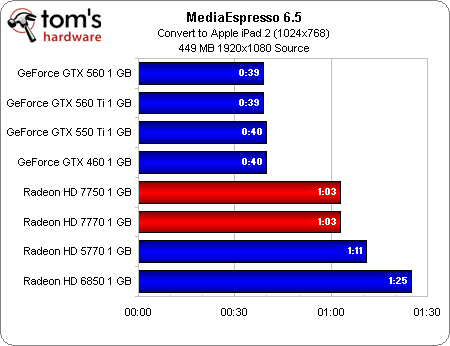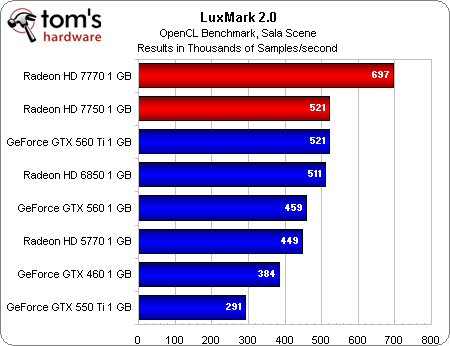AMD Radeon HD 7770 And 7750 Review: Familiar Speed, Less Power
These are the lowest-end cards built using AMD's new Graphics Core Next architecture. Is 28 nm manufacturing, a fresh design, and new functionality enough to warrant upgrading existing value-oriented champs like the Radeon HD 6850 and GeForce GTX 460?
Benchmark Results: MediaEspresso And Luxmark 2.0
We still have no idea why AMD’s cards cannot seem to manage hardware-accelerated encoding in MediaEspresso, despite this being a supported feature. It used to work, and now it doesn't.
By default, the application chooses to use Nvidia’s GPU-based encoding, but leaves decoding disabled. It also turns off AMD’s UVD block, but we manually turn that on so at least some piece of the GPU is taking part in this test (encoding is greyed out entirely).
The GeForce GTX 460 and 500-series cards all manage roughly the same performance, despite different shader configurations. Meanwhile, the Radeon HD 7700s outperform AMD’s older cards, which, despite benefiting from fixed-function decode logic, fall way behind.
Based on a new SmallLuxGPU2 rendering engine with multi-platform OpenCL support, the second generation of LuxMark includes a couple of more complex scenes. We’re using the Sala scene, with more than 488 000 triangles.
Despite their more modest gaming capabilities, both of these cards clearly have a lot of compute potential. The Radeon HD 7770’s lead is clear, and the fact that the $109 Radeon HD 7750 ties the $200+ GeForce GTX 560 Ti is a testament to the improvements AMD’s architects made in shifting to GCN.
Get Tom's Hardware's best news and in-depth reviews, straight to your inbox.
Current page: Benchmark Results: MediaEspresso And Luxmark 2.0
Prev Page Benchmark Results: Sandra 2012 Next Page Power Consumption-
Derbixrace the 7750 will be a GREAT card compared to the 6670 for those who have a shitty 300w PSU and wants a nice GPU.Reply -
phamhlam If the 7770 is the same price as the 6850. I think we have the best value card right here. The 6850 was a great budget card but this card will change that.Reply -
dragonsqrrl "Although other cards beat it in encryption and decryption performance, the Radeon HD 7750 easily secures a second-place finish in the SHA256 hashing test."Reply
I think you mean AES256. -
jprahman The fight shaping up between all these new AMD cards and Kepler is looking to be a good one. Time to just sit back with some popcorn and enjoy the show... while planning a new build for when the price war breaks out.Reply -
esrever Seems ok, New stuff ussually cost more. The 6770 being more expensive than the 5770, the 6870 being more expensive than the 5850 ect.Reply
I'd expect prices to go down once supply goes up and demand goes down. -
confish21 What a sad release. I'm not even excited for Pitcairn now! I foresee the $170 6870 to hold its own.Reply -
This is ridiculous. Man this sucks, i've been waiting for the 7770 since early last year, and this crap is what they release?Reply
What_were_they_thinking? -
wicketr Well....here's hoping for a good 7850/7870 release on March 6th. Not much here worth spending money on IMO.Reply -
buzznut This is unfortunate, considering the naming scheme. The 4770, 5770, and 6770 were/are all good budget cards that performed above where they were priced. Bang for buck has always been the draw here, but that 7770 is overpriced. Hopefully AMD will see this fumble; I agree at $120-130 this card makes a lot more sense.Reply
I'd actually like to see the HD 7750 at a lower price too, as we know these prices will drop over time but I still think this is slightly high for launch.


